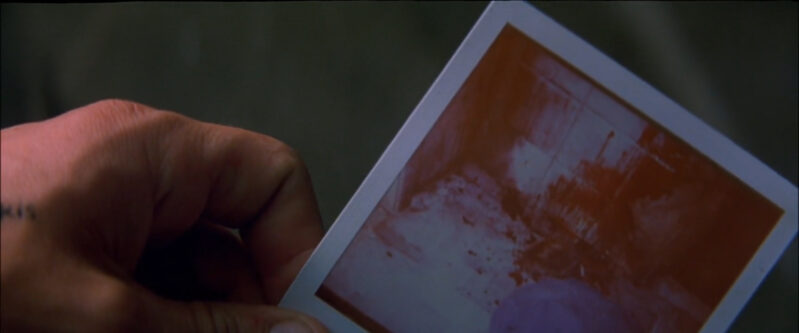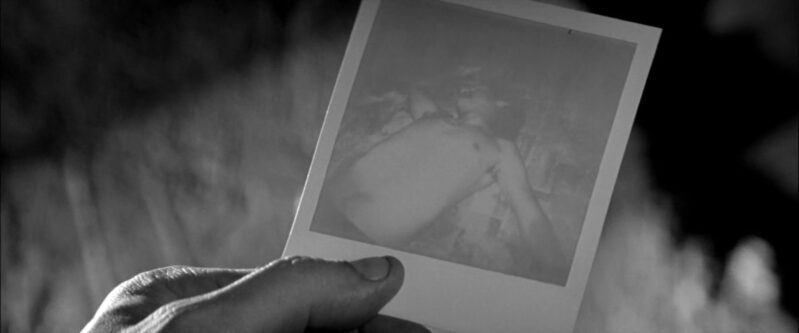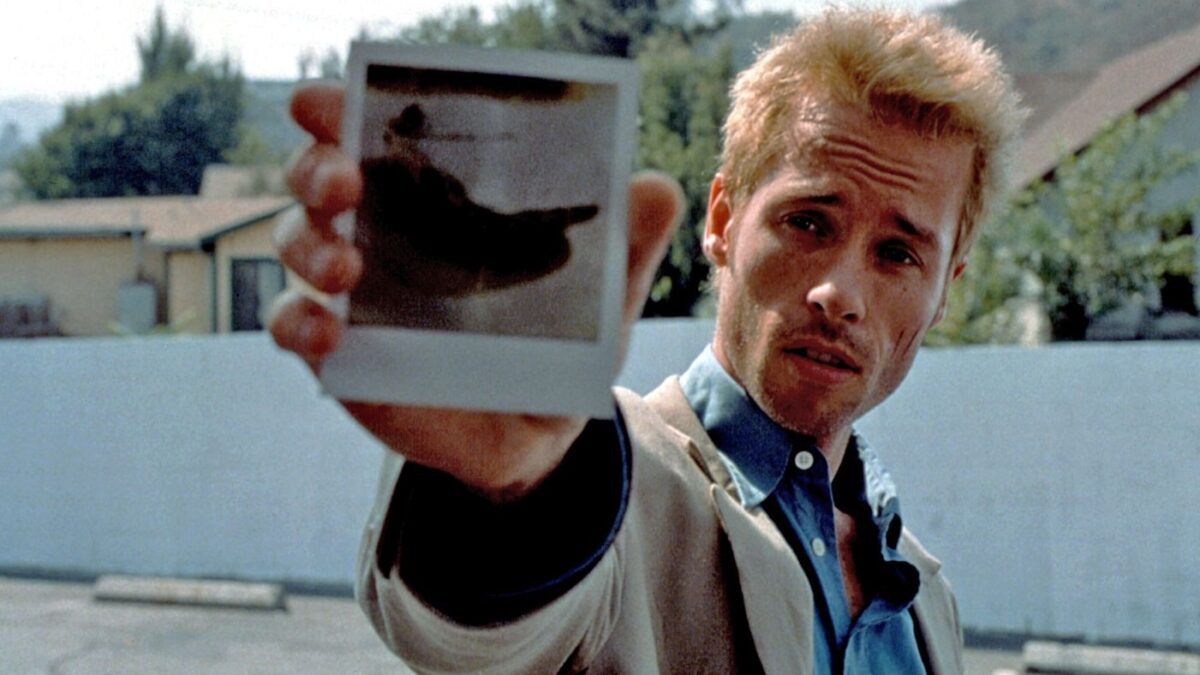In this section of our Colossus Movie Guide for Memento, we look at the key shots that help us understand the film.
Cast
- Guy Pearce – Leonard Shelby
- Carrie-Anne Moss – Natalie
- Joe Pantoliano – John Edward “Teddy” Gammell
- Mark Boone Junior – Burt
- Russ Fega – Waiter
- Jorja Fox – Catherine Shelby
- Stephen Tobolowsky – Samuel R. “Sammy” Jankis
- Harriet Sansom Harris – Mrs. Jankis
- Thomas Lennon – Doctor
- Callum Keith Rennie – Dodd
- Christopher Nolan – Writer and director
Key shots of Memento
The First and Final Polaroids


The opening shot of Memento features a Polaroid photo of a murdered body fading instead of developing, a sequence that takes place in reverse. This shot serves a dual purpose: it immediately signals the film’s unconventional, non-linear structure and introduces the audience to Leonard’s anterograde amnesia, where new experiences fade as quickly as they occur, much like the Polaroid.
This idea of the fading Polaroid is echoed in the final shot of the film, where Leonard takes a Polaroid of Teddy after deciding that he will be his next target. The image of Leonard driving away, waiting for the Polaroid to develop, bookends the film and brings a sense of resolution to its exploration of memory and truth.
The Polaroids serve as an external memory system for Leonard, but the initial fading and final development of these photos highlight the subjective nature of his “memories.” The fading Polaroid in the opening sequence underlines the fleeting, unreliable nature of memory, while the developing Polaroid in the final shot emphasizes Leonard’s active role in shaping his own memory and identity. Thus, these two shots, though appearing to be at odds with each other, ultimately work together in a symbolic sense.
Leonard and His Tattoos

The shot where Leonard examines his tattoos in the mirror is significant in terms of character exploration. Mirrors in films are often used as a device for characters to engage in self-reflection or to reveal aspects of their identity to the audience. In Memento, this convention is used effectively to comment on Leonard’s unique predicament.
As Leonard inspects his tattoos, the mirror serves as a literal reflection of his identity. The tattoos are external markers of his past, a coded narrative of his experiences that he must decipher each day. The act of examining his tattoos in the mirror is an act of self-discovery, a daily ritual of reconstructing his identity.
However, the mirror also introduces an element of distortion and reversal, suggesting the potential for manipulation and deceit. As the film progresses, we learn that Leonard’s tattoos, which he perceives as immutable truths, are in fact susceptible to his desires and fears. This shot, therefore, not only offers a profound insight into Leonard’s character but also underscores the idea that our perceptions of ourselves, much like our reflections in the mirror, can be distorted and manipulated.
Leonard Burns His Wife’s Belongings

A pivotal shot in Memento is when Leonard burns his wife’s belongings, including a book she read over and over. Leonard recalls a memory when he asks his wife why she continues to read it, especially when “the pleasure of a book is in wanting to know what happens next,” she simply says, “I enjoy it.” This conversation sheds light on the film’s thematic intentions on multiple levels.
By burning the book, along with other personal items, Leonard’s attempts to sever ties with his painful past. Yet, given his condition, this act becomes a tragic irony as he won’t remember it. The memory of his wife, the book, and their conversations will resurface, keeping him tethered to the past he’s trying to escape.
The book can also be seen as a metaphor for Leonard’s own narrative. Just as a reader navigates through the pages of a book to understand the story, Leonard navigates through his Polaroids and tattoos to make sense of his life. However, unlike a book that has a fixed narrative, Leonard’s story is constantly changing, manipulated by both himself and others.
The act of burning the book is an attempt at creating a definitive ending, a closure to his past. But as the narrative of Memento shows, Leonard’s story is far from having a clear end. This shot, therefore, encapsulates the film’s exploration of memory, grief, obsession, and the elusive nature of closure.
Sammy Injects the Insulin

One of the most pivotal shots in Memento is the flashback of Sammy Jankis injecting his wife with insulin, a memory that turns out to be Leonard’s own. This scene is a critical turning point in the narrative, as it forces both Leonard and the audience to question the reliability of memories and the narratives we construct around them.
The flashback occurs as Leonard explains Sammy’s story, suggesting that Leonard has unwittingly projected his own guilt onto Sammy, creating a fictional story to absolve himself. This revelation fundamentally shifts our understanding of Leonard’s character and his motivations. It also underscores the film’s exploration of memory, guilt, and self-deception.
The insulin injection scene, while appearing to be about Sammy, is actually a stark reminder of Leonard’s own tragic past. It suggests that Leonard, in his confusion and grief, administered a lethal dose of insulin to his diabetic wife, leading to her death. This realization forces Leonard, and by extension the audience, to confront the uncomfortable truth that he is his wife’s killer. This shot is significant as it unravels the film’s central mystery and introduces a new level of complexity to Leonard’s character. It illustrates the malleability of memory and the lengths one can go to escape guilt.
What are your thoughts?
Are there more shots you think should be part of the Colossus Movie Guide for Memento? Leave your thoughts below and we’ll consider adding them.

